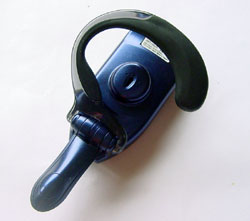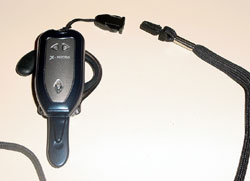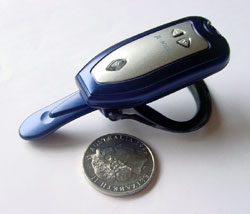|
|
Advertisement:
|
|
X-Micro Bluetooth Headset |
|
Join the community - in the OCAU Forums!
|
Audio Quality, Voice Dialling, Comfort, Conclusions
Audio Quality
Bluetooth audio is transmitted on a 64kbps SCO (Synchronous Connection Oriented) link. This means the data capacity on the Bluetooth link is always reserved, so other connections (i.e. file transfer) don’t interfere with the audio operation (although their speed might be reduced). The audio coding used on the channel is typically 8-bit u-law or 8-bit a-law (although a more complex scheme called CVSD can be used as well).
The quality of the downlink to the headset (i.e. the speaker) was quite clear when used to transmit voice information, and general Windows ‘noises’ (i.e. ICQ/MSN alerts, etc). Obviously, when playing music, the quality was certainly not CD quality, as Bluetooth audio is designed for voice applications. It’s similar to telephone quality.
The problems arose when trying to use the uplink channel (i.e. the microphone). There was evidently some problem with audio format conversion, as when establishing a voice conversation with MSN messenger, the voice was heavily distorted and rather quiet. I tested this further by using Windows “Sound Recorder” to record my voice. When I played back the audio, my voice was played back faster (than real-time) and distorted. I then changed the format from PCM – 8kHz/8bit/mono to u-law – 8kHz/8bit/mono. This resulted in much cleaner audio at normal speed. I can only conclude somewhere in the software chain the audio conversion from the Bluetooth headset’s native format to PCM is not happening properly. The device is certainly capable of good quality voice in both directions.
X-Micro were unable to reproduce this problem when we reported it, but I've tested the headset with different versions of the WIDCOMM software on different Bluetooth equipped computers with the same result. Note that it only affected communication with the PC's - talking on a mobile phone via headset was unaffected.
As for the range – I was able to walk around freely in about a 7m or so radius of the PC whilst maintaining the same audio quality. However, once I started to exceed this range, the audio would start to stutter if my head was positioned in such a way as that it obstructed line-of-sight from the headset to the PC.
Voice Dialling
The device (when paired with a mobile) allows a call to be placed without needing to touch the mobile phone, providing the mobile has voice dialing capability. Pressing the power button in idle (but paired) mode causes the phone to activate its voice recognition feature. I was unable to test this feature due to my 7650 not supporting the headset profile, however if the phone already has reliable voice dialing, I see no reason why this function wouldn’t work.
Comfort & Style
The headset has two pieces which fold out from the underside – the microphone and the ‘earhook’. The earhook hooks around on the other side of your ear (the side facing your face), and then the headset is closed, gripping your ear on both sides. Whilst this may sound uncomfortable, it’s not – the grip feels light but is reasonably firm. I was able to walk whilst being confident that the headset was not slipping and still firmly attached. Running or jogging however would probably cause the headset to eventually fall off.

I weighed the headset with digital scales to be a light 25g – right about what the manufacturer claimed (26g). Even after fairly extended periods of wearing the headset for an hour or more it did not become uncomfortable.
The unit came set up for the right ear (interestingly all the pictures on the box showed models wearing it on the left ear). Instructions were provided on how to remove the earhook, and put it on in reverse, for left ear use. Sounds simple, but in reality this procedure involved stretching the plastic to try and remove the earhook (with the constant threat of breaking if I pulled just a little too hard), and then trying to fit it back over the two notches the other way around (also with the threat of breaking if I pushed too hard).
The unit also included a strap to wear it around your neck, with a clip that allows the headset to be detached from the strap . When a call comes in, you can quickly detach it from the cord and move it to your ear.

As for the appearance of the device, this is certainly subjective, but I found the colors quite appropriately chosen and the look of the device visually appealing. Obviously, any Bluetooth headset is going to get odd glances in public, however. But so did mobile phones when they first came out!

Battery Life
The unit has an internal rechargeable battery. The manufacturer claimed 100 hours of standby time and 4 hours of talk time. In my experimenting, I found both of these claims to be accurate. These times were comparable to the talk and standby times of many current phones, so for those that always use the headset, it could be a good idea to charge the headset whenever the mobile is charged, to minimize the chance of the headset running out of power during a call.
When the power began to run low, when there was around 5 minutes of talk time left, a tone would interrupt the audio every 15 seconds or so, until the device cut out. I would have liked to see the device give earlier notice – but with a different mechanism such as perhaps flashing the red LED when there was perhaps 15-20 minutes of talk time left (including when idle) and then sounding the tones at the 5 minute mark if an audio connection was in progress.
The headset was supplied with an AC charger which plugs into the top. When charging, the red light illuminates until the charging is finished, usually about 1.5-2 hours with an empty battery. The charger had a slim mains plug as well, which is great for plugging into standard power boards, as you can still use the point on either side.
Conclusion
The X-Micro Bluetooth Headset was comfortable and light to wear, and delivered a clear quality voice channel. It was also easy to configure and use. People who want to avoid a wire-based hands free kit with their mobile should seriously consider one of these. Unfortunately the audio format problems stopped the device from being used for PC-based audio conversations (through MSN messenger, etc). I am not clear on what component in the chain from the software to the headset was to blame for this.
Altech Computers distribute X-Micro products in Australia.
|
|
Advertisement:
All original content copyright James Rolfe.
All rights reserved. No reproduction allowed without written permission.
Interested in advertising on OCAU? Contact us for info.
|

|


